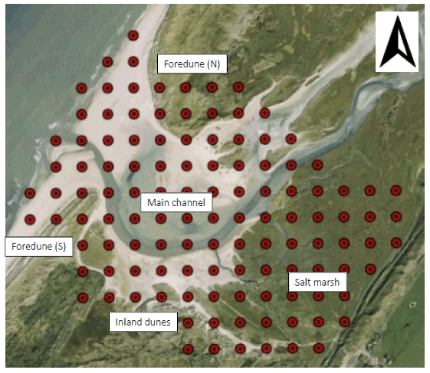M.A. Prins1, Y. Cuijpers1, J.A. van Hateren1, J.B.W. Stuut1,2, S.R. Troelstra1
1 Vrije Universiteit Amsterdam,
2 NIOZ
Introduction
The way in which sediment is transported (creep, saltation, suspension), is traditionally interpreted from grain size distribution characteristics. However, the grain size range associated with transitions from one transport mode to the other is highly variable because it depends on the amount of transport energy available. In this study we present a second application of a novel methodology for determination of sediment transport modes based on end-member modelling of grain size and shape data from dynamic image analysis (see contribution by van Hateren et al).
Methods and approach
The grain size-shape distribution of surface sediment samples (Fig. 1) from an active secondary tidal inlet system along the Dutch coast – the Slufter nature reserve on the island of Texel – are decomposed into a series of primary components by end-member modelling (Fig. 2, upper panel). The spatial distribution of these components (Fig. 2, lower panel) is controlled by the dominant transporting media (water, wind), geomorphology and vegetation cover and reflects the main processes of sediment transport in this mixed aeolian-tidal sedimentary system: wave- and tidal-current-dominated transport of 'coarse' sand on the beach and in the main inlet channel, aeolian transport of 'fine' sand in the coastal dunes, and tidal-current transport of 'fine' sands and 'very fine' mud in the vegetated salt marsh. Figure 1 Sample grid across the Slufter nature reserve.

Results & conclusions
The different transport modes and transporting media are characterised by different grain size-shape distributions. Bedload transport by water is characterised by coarse sand and a constant grain regularity with increasing size (EM1, EM2). Bedload transport by wind is also characterised by a constant grain regularity with increasing size, but the distribution is finer-grained (EM2, EM3). Suspension transport of sand in the main channel by water is characterised by a strong decrease in grain regularity with increasing size (EM4). Suspension transport of silts by water shows a strong decrease in grain regularity with increasing size (EM5). The grain size-shape distributions can thus be used to determine the transport mode and potentially also the transporting medium for a sedimentary deposit.

Figure 2 Modelled end-member grain size-shape distributions (upper graphs) and their spatial distribution across the Slufter nature reserve (lower graphs).
I. Surname1*, F.N. Another-Surname2 , Y. Next-Surname2
1 University Name, Country; 2 Organization Name, Country
* Corresponding author: mail.name@organization.org


